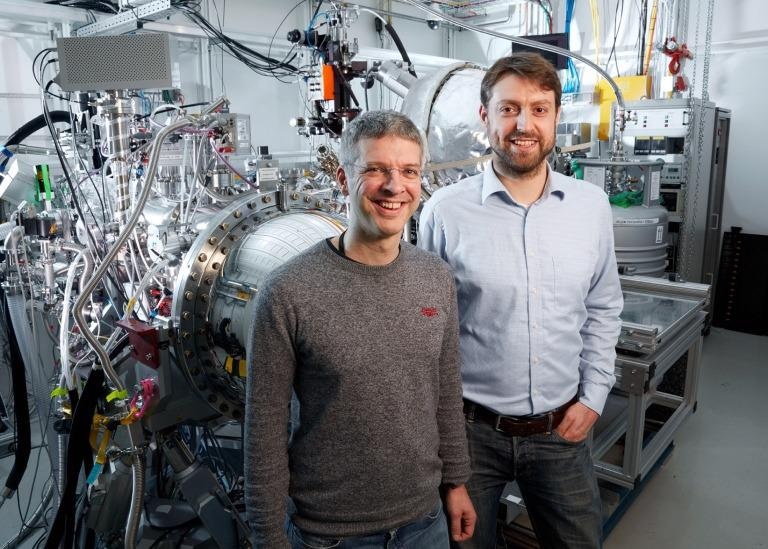For the first time, a collaborative research team directed by scientists from Stockholm University has been able to examine a copper-zinc catalyst’s surface when carbon dioxide (CO2) is reduced to methanol (CH3OH). The results were acquired using DESY´s excellent light source PETRA III and have been reported in the journal Science.
 Christopher Schlüter together with Peter Amann in the experiment hutch of P22. Image Credit: Stockholm University
Christopher Schlüter together with Peter Amann in the experiment hutch of P22. Image Credit: Stockholm University
Better awareness of the catalytic process of methanol creation and the likelihood of discovering even more efficient materials paves the way for a green shift in the chemical sector.
Methanol is presently one of the most essential basic petrochemicals with a production of 110 million tons per year. It can be changed into tens of thousands of diverse products and used to manufacture things like detergents, pharmaceuticals, plastics and fuels.
Methanol also has the prospect of becoming a future energy carrier, for example by manufacturing aviation fuel from captured CO2 and hydrogen (H2) from the electrolysis of water. A future green revolution of the chemical sector, akin to the one with green steel, where solar or wind energy powers electrolytic cells is, therefore, a likelihood.
The technical making of methanol occurs in a catalytic process where a combination of CO2, carbon monoxide (CO) and H2 reacts to CH3OH. The catalyst comprises a mixture of zinc oxide, copper and aluminum oxide. However, the fundamental function and the chemical state of the catalyst constituents in the course of the reaction have never been solved — until now.
The challenge has been to experimentally investigate the catalyst surface with surface-sensitive methods under real reaction conditions at relatively high pressures and temperatures. Those conditions have for many years not been achievable and different hypotheses about zinc being available as oxide, metallic or in alloy with copper arose but could not be unambiguously verified.
Anders Nilsson, Professor of Chemical Physics, Stockholm University
“It is fantastic that we have been able to shed light into this complex topic of methanol formation over copper-zinc catalyst after many years of effort.” says Peter Amann, first author of the publication.
The investigations have been carried out at PETRA III beamline P22, devoted to studying the atomic and electronic structure of interfaces, surfaces, and bulk materials using photoelectron spectroscopy.
“What is special is that we have built a photoelectron spectroscopy instrument in Stockholm that allows studies of catalyst surfaces under high pressures and thereby directly been able to observe what happens when the reaction takes place,” says David Degerman, PhD student in Chemical Physics at Stockholm University. “We have opened a new door into catalysis with our new instrument”.
We have succeeded using our instrument to demonstrate that zinc is alloyed with copper right at the surface and this provides special atomic sites where methanol is created from carbon dioxide. During industrial processes, a small amount of carbon monoxide is mixed in, which prevents the formation of zinc oxide from carbon dioxide.
Chris Goodwin, Researcher in Chemical Physics, Stockholm University
“The innovative spectroscopy instrument design from Stockholm University in combination with the PETRA III beam parameters now allows in-operando experiments of catalysts at pressures ten times higher than at other synchrotron light sources”, says DESY´s Christoph Schlueter, beamline scientist at P22.
To have our Stockholm instrument at one of the brightest x-ray sources in the world at PETRA III at DESY in Hamburg has been crucial to conduct the study. We can now imagine the future with even brighter sources when the machine upgrades to PETRA IV.
Patrick Lömker, Postdoctoral Researcher, Stockholm University
In the study, the scientists could establish various behaviors of the catalyst´s surface contingent on the fraction of CO2 and CO in the gas mixture — a starting point to enhancing current or even finding new better catalysts.
We now have the tools to conduct research leading to possible other catalyst materials that can be used better to fit together with electrolysis-produced hydrogen for the green transition of the chemical industry, which today is completely fossil-based and accounts for 8% of the worldwide carbon dioxide emissions.
Anders Nilsson, Professor of Chemical Physics, Stockholm University
The study was carried out as a partnership between the University of Stockholm and the University of Innsbruck, Vienna Technical University, DESY, and the Fritz-Haber Institute in Berlin. The study included former employees at the University Peter Amann, Joakim Halldin Stenlid, Markus Soldemo, Mikhail Shiplin, Hsin-Yi Wang, Jörgen Gladh, and Mia Börner.
Journal Reference:
Amann, P., et al. (2022) The State of Zinc in Methanol Synthesis over a Zn/ZnO/Cu(211) Model Catalyst. Science. doi.org/10.1126/science.abj7747.